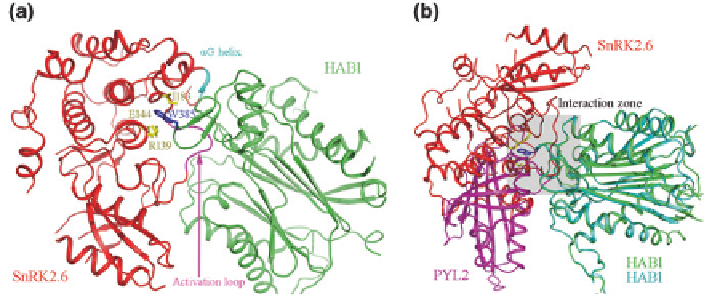Agriculture Reference
In-Depth Information
Fig. 7.9
Structures of the SnRK2.6-HAB1 complex (pdb ID: 3UIG).
a
A structure overview.
SnRK2.6 is shown in
red
, HAB1 is colored
green
. The three separate regions within the kinase
domain of SnRK2.6 for binding to HAB1 are shown, the activation loop is colored
magenta
and
the
ʱ
G helix is colored
cyan
. Besides, residues Arg139, Ile183, and Glu144 (
yellow
) of SnRK2.6
make an interaction with the conserved ABA-sensing tryptophan (Trp385 in HAB1,
blue
).
b
Overlay of the interaction surfaces in the SnRK2.6-HAB1 and PYL2-ABA-HAB1 complexes
gate loop of PYLs; second, the region near residues Arg139, Ile183, and Glu144
of SnRK2.6 mimics the cleft formed by the gate-and-latch loops of PYLs and
the conserved tryptophan (such as Trp385 in HAB1) from PP2Cs inserts into this
region; third, the SnRK2.6
ʱ
G helix binds to the region near the PYLs interac-
tion site in HAB1 (see Fig.
7.9
a). The SnRK2s-PP2Cs interface largely overlaps
with the PYLs-PP2Cs binding interface; the HAB1 structure in the SnRK2.6-
HAB1 complex is nearly identical to that in the PYLs-HAB1 complex. Thus, both
SnRK2.6 and PYLs use a similar gate-and-lock mechanism to recognize PP2Cs
(see Fig.
7.9
b) (Soon et al.
2012
).
In
Arabidopsis
, there are 14 members of PYLs, nine members of PP2Cs, and 10
members of SnRK2s, differential binding between PP2Cs and PYLs, PP2Cs and
SnRK2s is important for regulating the physiological responses of
Arabidopsis
to
the stress conditions. And the common recognition mechanism of gate-latch-lock
likely ensures the signaling pathway by preventing the inappropriately regulation.
7.4 Chemical Regulation of PYLs
ABA agonists may be able to improve the yield of crop plants under different
stresses as well as to manipulate ABA response in different tissues or in develop-
mental stages. Pyrabactin was first identified as a synthetic and receptor-selective
ABA agonist, which led to the identification of PYR1 (Park et al.
2009
). Through
years' research, the complex structures of PYL1, PYL2, PYL3, and PYR1 with
pyrabactin were reported (Hao et al.
2010
; Melcher et al.
2010
; Yuan et al.
2010
;

Search WWH ::

Custom Search